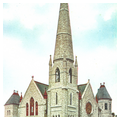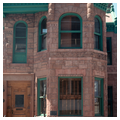Trinity United Methodist Church is the finest building of Colorado's first licensed architect. The light weight of volcanic rhyolite from the Castle Rock quarries in Douglas County allowed Robert Roeschlaub to design a 181-foot-high hexagonal corner steeple in stone. The same rhyolite lends multi-colored hues and a rough texture to downtown's oldest church. Tooled purple Utah sandstone trim includes three horizontal contrasting stripes in the steeple. This allusion to the Trinity is repeated in the triple-arched entry on Broadway and in Gothic windows arranged in sets of three.
Inside, Roeschlaub's 1,200-seat sanctuary resembles a theater, where a large proscenium arch frames a 4,000-pipe Roosevelt organ. Electric lights on the arch, box seats, and a balcony lend opera hall drama. Most of the stained glass windows are by Healy and Millet of Chicago, fabricators for Louis Sullivan. The solid bronze and oak pulpit commemorates the church's most famous pastor, the Reverend Henry Buchtel, who also served as chancellor of the University of Denver and governor of Colorado.
In 1982 Trinity sold its air rights to a Toronto developer (who never used them) for a $2 million endowment in addition to restoration of the church and construction of a subterranean office, education, and parking complex under a park. This exquisitely designed and preserved church of Denver's oldest religious congregation has superb acoustics, making it a favorite site for public lectures and musical performances.








